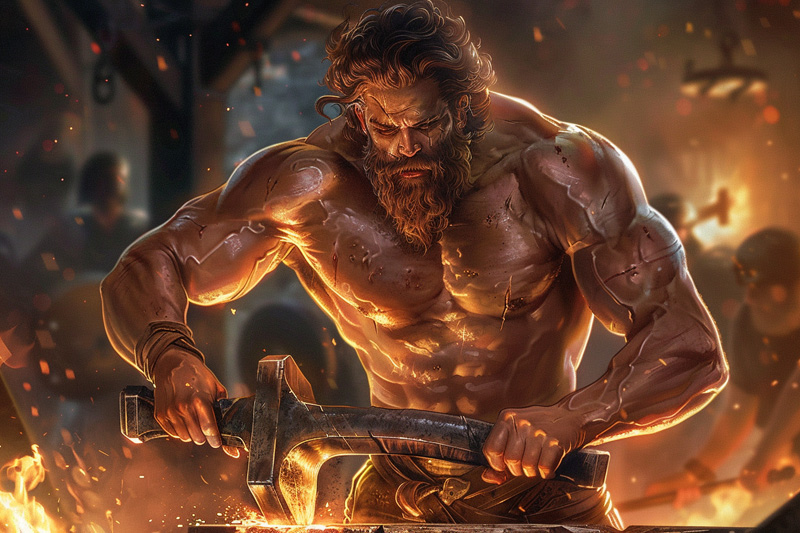KidZone Geography: Greek Mythology
About Hephaestus, God of Fire and Craftsmanship
Introduction to Hephaestus
Hephaestus, one of the twelve Olympian deities in Greek mythology, is the god of fire, metalworking, and craftsmanship. Known for his skills as a blacksmith, Hephaestus is often depicted forging weapons and armor for gods and heroes. Despite his physical imperfections, Hephaestus's talents and creativity make him a revered and essential figure in Greek mythology.

Quick Facts About Hephaestus
What is Hephaestus the Greek god of?
Hephaestus is the Greek god of fire, metalworking, and craftsmanship. He is renowned for his ability to create magnificent weapons, armor, and various other items for the gods and heroes of Greek mythology.
What are Hephaestus's sacred animals?
Hephaestus's sacred animals include the donkey and the crane. The donkey symbolizes his laborious nature and steadfastness, while the crane represents his creative and constructive abilities.
What are Hephaestus's symbols?
Hephaestus's primary symbols are the anvil, the hammer, and the tongs. These tools represent his craftsmanship and skill in metalworking. The forge, where he creates his masterpieces, is also a significant symbol associated with Hephaestus.
Origins and Birth
The Fall from Olympus
Hephaestus's origin story is marked by his dramatic fall from Olympus. Born to Zeus and Hera, or in some versions to Hera alone, Hephaestus was thrown from Mount Olympus by his mother due to his physical deformities. He landed in the sea and was rescued by sea nymphs Thetis and Eurynome, who raised him in a grotto. Despite his challenging beginnings, Hephaestus honed his skills as a blacksmith and craftsman, eventually earning a place among the Olympian gods.
Return to Olympus
Hephaestus's return to Olympus is a testament to his incredible talent and resilience. His skill in crafting exquisite and powerful items impressed the gods, leading to his reinstatement as one of the Olympians. He built his workshop on Olympus, where he created many famous mythological items, including Zeus's thunderbolts and Achilles's armor.
Hephaestus's Role in Greek Mythology

Master Craftsman
Hephaestus's primary role in Greek mythology is as the master craftsman of the gods. He is responsible for creating some of the most iconic items in Greek mythology, such as Hermes's winged helmet and sandals, Aphrodite's girdle, and the armor of various heroes. His forge, often depicted as a fiery workshop filled with anvils and hammers, is the birthplace of these legendary creations.
God of Fire
Hephaestus is also the god of fire, both in its destructive and creative forms. He harnesses the power of fire to shape metal and create objects of great beauty and utility. This duality reflects his complex character, balancing the raw, untamed nature of fire with the precision and artistry of craftsmanship.
Iconography and Symbols
The Anvil and Hammer
The anvil and hammer are Hephaestus's most recognizable symbols, representing his role as the blacksmith of the gods. These tools are essential in his craft, allowing him to shape and mold metal into various forms.
The Forge
The forge is a significant symbol associated with Hephaestus. It represents his domain and the source of his power. In mythology, his forge is often depicted as a subterranean workshop filled with fire and metalworking tools.
The Tongs
Tongs are another important symbol of Hephaestus, signifying his craftsmanship and ability to manipulate fire and metal. They are often depicted in his hands as he works at his forge.

Major Myths Involving Hephaestus
The Creation of Pandora
One of Hephaestus's most famous myths is the creation of Pandora, the first woman. Zeus ordered Hephaestus to create her as part of a punishment for humanity. Hephaestus molded her from clay, and she was given life and endowed with gifts from the other gods. Pandora's curiosity led to the release of all the world's evils when she opened the forbidden jar, leaving only hope inside.
The Binding of Prometheus
Hephaestus also played a role in the punishment of Prometheus. After Prometheus stole fire from the gods and gave it to humanity, Zeus ordered Hephaestus to bind him to a rock as punishment. Hephaestus reluctantly followed Zeus's orders, chaining Prometheus to the rock where he would endure a daily torment.
The Golden Throne of Hera
Hephaestus crafted a magnificent golden throne for his mother, Hera. However, it was a trap designed to bind her as revenge for casting him out of Olympus. When Hera sat on the throne, she became trapped, and none of the gods could free her. Hephaestus eventually released her in exchange for a place among the Olympians and Aphrodite's hand in marriage.
Hephaestus's Relationships and Offspring
Marriage to Aphrodite
Hephaestus was married to Aphrodite, the goddess of love and beauty. Despite their union, Aphrodite was unfaithful, having an affair with Ares, the god of war. This infidelity led to one of the most famous myths involving Hephaestus, where he crafted a fine net to catch the lovers in the act, exposing them to the ridicule of the other gods.
Other Relationships
Hephaestus had relationships with various other figures in Greek mythology, resulting in several offspring. His children include:
- Eucleia: The goddess of good repute and glory.
- Euthenia: The goddess of prosperity.
- Philophrosyne: The goddess of friendliness and kindness.
- Cabeiri: Mystical deities associated with the island of Lemnos and metalworking.
Worship and Cult of Hephaestus

Temples and Sanctuaries
Hephaestus was worshipped throughout ancient Greece, with several temples and sanctuaries dedicated to him. The most notable of these is the Temple of Hephaestus in Athens, located near the Agora. This well-preserved temple, also known as the Hephaisteion or Theseion, served as a center for worship and a testament to his importance in Athenian society.
Festivals and Rituals
Various festivals celebrated Hephaestus's skills and contributions, with the most notable being the Chalkeia and the Hephaesteia. The Chalkeia, held in Athens, honored both Hephaestus and Athena as patrons of crafts and metalworking. The Hephaesteia included contests, sacrifices, and processions, celebrating his role as the divine blacksmith.
Hephaestus in Art and Literature

Classical Depictions
In classical art, Hephaestus is often depicted as a bearded man with a muscular build, holding a hammer or tongs and working at his forge. These representations emphasize his strength and skill as a craftsman, despite his physical imperfections.
Renaissance and Beyond
During the Renaissance, artists like Giorgio Vasari and Tintoretto drew inspiration from classical depictions of Hephaestus, incorporating him into their works. Vasari's painting "Vulcan's Forge" and Tintoretto's "The Forge of Vulcan" highlight the dramatic and industrious nature of Hephaestus's domain.
Modern Interpretations
In modern times, Hephaestus continues to be a prominent figure in literature, film, and popular culture. He appears in various forms, from comic books and movies to television series and video games. These contemporary portrayals often explore different aspects of his character, from his creative genius to his complex relationships. In the Percy Jackson series, for example, Hephaestus is depicted as a wise and resourceful god, reflecting modern interpretations of his myth.
Conclusion
Hephaestus remains one of the most intriguing figures in Greek mythology. His role as the god of fire, metalworking, and craftsmanship, combined with his complex personality and significant myths, make him a fascinating character. As the master craftsman of the gods, Hephaestus's creations have left a lasting impact on mythology and culture. Through his worship, iconography, and the rich tapestry of stories that surround him, Hephaestus exemplifies the ingenuity and creativity of ancient Greek religion and mythology. His enduring influence can be seen in the continued fascination with his myths and the artistic representations that keep his legend alive.


